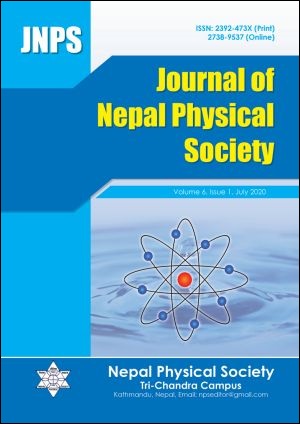Variation on Atmospheric Transmittance Solar Radiation at Kathmandu Valley
DOI:
https://doi.org/10.3126/jnphyssoc.v6i1.30558Keywords:
Air mass, atmospheric transmittance, global solar radiation, meteorological parameters, ozoneAbstract
The daily solar irradiance was measured using CMP6 first class pyranometer at the horizontal surface of Kathmandu Valley (Lat.:-27.7° N, Long.:-85.5° E, Alt. 1350 m above sea level.) from January to December, 2012 (one year). Monthly mean of atmospheric transmittance is calculated based on different meteorological parameters. The effect of different meteorological parameters as well as physical parameters on the atmospheric transmittance of solar radiation was analyzed. The maximum and the minimum monthly mean solar radiation are found to be 21.32 ± 4.14 MJ/m2/day and 10.93 ± 2.03 MJ/m2/day in May and January, respectively. The value of yearly mean solar radiation measures is 16.68 ± 4.60 MJ/m2/day. Similarly, the annual average of atmospheric transmittance value of 0.51 ± 0.12 was obtained that was due to cloudy and more precipitation day during the months of measurements taken. The yearly mean of atmospheric transmittance 0.983, 0.987, 0.698 and 0.889 are found due to Rayleigh scattering followed by ozone, water vapor, gas mixture and aerosols respectively, the maximum atmospheric transmittance due to water vapor and while minimum due to gas mixture. This research work will be beneficial for the further identification of other affecting factors of different parameters for the interaction with radiation at different places of the country.
Downloads
Downloads
Published
How to Cite
Issue
Section
License
All right reserved. No part of this Journal may be reproduced in any form or by any electronic or mechanical means, including information storage and retrieval system, without permission in writing from the publisher, except by a reviewer who may quote brief passage in a review. The views and interpretation in this journal are those of author(s) and they are not attributable to the NPS.




